Monday, March 15, 2021 04:00PM / by NBS/ Header Image Credit: NBS
Highlights
- Thenumber of persons in the economically active or working age population (15 - 64years of age) during the reference period of the survey, Q4, 2020 was122,049,400. This is 4.3% higher than the figure recorded in Q2, 2020, whichwas 116,871,186.
- Thenumber of persons in the labour force (i.e., people within ages 15 -64, who areable and willing to work) was estimated to be 69,675,468. This was 13.22% lessthan the number persons in Q2, 2020. Of this number, those within the agebracket of 25-34 were highest, with 20,091,695 or 28.8% of the labour force.
- The totalnumber of people in employment (i.e., people with jobs) during the referenceperiod was 46,488,079. Of this number, 30,572,440 were full-time employed(i.e., worked 40+ hours per week), while 15,915,639 were under-employed (i.e.,working between 20-29 hours per week). This figure is 20.6% less than the people in employment in Q2, 2020.
- Theunemployment rate during the reference period, Q4, 2020 was 33.3%, an increasefrom the 27.1% recorded in Q2, 2020. The underemployment rate declined from28.6% in Q2, 2020 to 22.8%.
- Theunemployment rate among rural dwellers was 34.5%, up from 28.2% in Q2, 2020,while urban dwellers reported a rate of 31.3% up from 26.4%. In the case ofunderemployment among rural dwellers, it declined to 26.9% from 31.5%, whilethe rate among urban dwellers decreased to 16.2% from 23.2% in Q2, 2020.
- For the period under review, Q4, 2020, the unemployment rate amongyoung people (15-34years) was 42.5% up from 34.9%, while the rate ofunderemployment for the same age group declined to 21.0% from 28.2% in Q2,2020. These rates were the highest when compared to other age groupings.
- Under State disaggregation, Imo State reported the highest rate ofunemployment with 56.6%, this was followed Adamawa and Cross River States with54.9% and 53.7% respectively. The State with the lowest rate was Osun in theSouth-West with 11.7%.
- For underemployment, the state which recorded the highest rate wasBenue with 43.5%, while Lagos State recorded the lowest underemployment rate,with 4.5% in Q4, 2020.
- A total number of 12,160,178 did not do any work in the last 7 dayspreceding the survey.
Introduction
In line with its statutory mandate to providegovernment and policymakers with reliable and timely information, the NationalBureau of Statistics routinely computes and disseminates the labour forcestatistics. These statistics presented in this report are generated from anationwide socio-economic survey, which sampled thirty-three thousand threehundred households across the country,both in urban and rural areas. Under this exercise, indicators such as theeconomically active population, labour force, unemployment and underemploymentrates were computed to inform the work of policymakers and government. The lastUnemployment survey conducted was in the 2nd quarter of 2020, whichproduced an unemployment rate of 27.1% and an underemployment rate of 28.6%.Following the success of the Telephone-based Abridged Labour Force Survey (LFS)under Covid-19, Quarter 2 (Q2) 2020, preparations continued to ensure thecontinuity of the production of this important economic indicator to providemuch needed information on the level of employment and unemployment in thecountry. Following the lifting of movement restrictions by government in the q42020, in line with set Covid-19 guidelines and protocols for interactions, NBSconducted this round of the survey using the usual face-to-face interview fordata collection. The results of the survey are hereby presented in this report.
Definitionsand Methodology
Labourforce and non-labour force
The total population in Nigeria is divided intolabour force (currently active) and non?óÔé¼?Élabour force (not currently active). The labourforce population covers all persons aged 15 to 64 years who are willing andable to work regardless of whether they have a job or not. The definition ofunemployment therefore covers persons (aged 15-64), who during the referenceperiod were available for work, actively seeking for work but were withoutwork. The non-labour force includes population below 15 or older than 64, aswell as those within the economically active population i.e., 15?óÔé¼?É64, who are unable towork, not actively seeking for work or choose not to work and/or are notavailable for work.
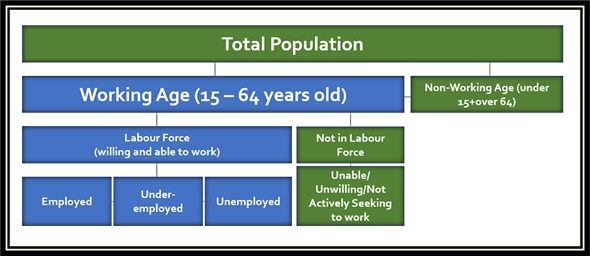
Examples of these are voluntary full-timehousewives, underage children 14 and below, adults above 65, full timestudents, those in active military service, physically challenged andincapacitated persons whose incapacitation prevents them from working. Growthin the labour force therefore fluctuates and depends on the decisions byconstituents of the economically active population on whether to work or notwhich varies across different cultures, religion, as well as various academic,economic, and family considerations. Forexample, a housewife might decide to take up employment to supplement thefamily income due to changes in the husband's salary or due to added familyneeds, or a person might decide to take some time off work to either study formaster's program or to recover from ill health.
Employmentand Unemployment
A person is regarded as employed if he/she isengaged in the production of goods and services, thereby contributing to theGross Domestic Product (GDP) in a legitimate manner, which is a component ofthe national accounts and receives any form or amount of compensation for thatactivity. Any of these can cause fluctuations in the economically active andlabour force population at any given time. There is no universal standarddefinition of unemployment as various countries adopt definitions to suit theirlocal priorities. However, all countries use the International LabourOrganization's (ILO) definition, or a variant of it to compute unemployment.The ILO definition covers persons aged15-64 who during the reference period (which is usually the week preceding thetime the survey is administered) were available for work, actively seekingwork, but were unable to find work.
The Nigerian National Bureau of Statistics, likemost countries in the world, uses a variant of the ILO definition such thatunemployment is the proportion of those in the labour force (not in the entireeconomic active population, nor the entire Nigerian population) who wereactively looking for work but could not find work for at least 20 hours duringthe reference period to the total currently active (labour force)population. Accordingly, you areunemployed if you did absolutely nothing at all or did something but for lessthan 20 hours during the reference week.
Hence, the unemployment rate is calculated as apercentage of the number of unemployed persons in the labour force:

Underemployment however occurs if you work lessthan full time hours, which is 40 hours, but work at least 20 hours on averagea week and /or if you work full time but are engaged in an activity thatunder-utilizes your skills, time, and educational qualifications. Consequently,rural farmers only farming seasonally will be considered underemployed if theyonly work on their farms during the planting and harvests period and do nothingin between. If farmers are however working in dry and wet seasons as is increasinglybecoming the case, they will then be involved in full time employment. Thisapplies to drivers, cooks, cleaners, bankers, teachers etc who in most casework well over 40 hours and hence are considered full time employed as theirworking hours and skills meet the adopted methodology.
It is important to note that the internationaldefinition of unemployment, underemployment or employment is not a function ofthe quantity/suitability of wages earned nor it is a function of jobsatisfaction. Rather employment, underemployment and unemployment are treatedstrictly as a function of a person's involvement or otherwise in economicactivity even if that activity is performed solely to make ends meet and notfor satisfaction or enjoyment. The suitability of wages or job fulfilment iscovered under other indices such as the living standard, poverty rate orhappiness index, but not in determining whether one is employed, unemployed orunderemployed, which is a function of economic engagement.
SurveyDesign and Methodology
Theapproach adopted in collecting the required information for this survey was theComputer Assisted Personnel interviewing (CAPI) approach. The data collectionwas carried out in all the 36 states of the Federation and Federal CapitalTerritory (FCT). Enumeration Areas (EAs) in both urban and rural areas werecanvassed for the exercise.
Thescope of this survey covered the following areas -
- Identificationof EnumerationAreas (EAs) and Households
- Demographiccharacteristics of Households Members
- Typeof economic activities that household members engaged in
- Workinghistory/occupational profile of the labour force
- Numberand characteristics of unemployed persons
The sample design was doneusing the National Integrated Survey of Household (NISH) Frame.A 2-stage selectionprocess was carried out to get the final sample size. First, 60Enumeration Areas were selected in each State and the FCT, making a totalnumber of 2220EAs nationwide. A further selection was done in each of the EAs with 15households selected for interview in each EA and 900 household per state covered.This gave a total of 33,300households nationwide, which is a robust sample for state level reporting.
There were 2 levels oftrainings conducted to adequately equip the interviewers and data monitors forthe exercise. The first was training of trainers (TOT). This was done at the Headquarters.Experienced officers from the headquarters were trained on the questionnaire developedand methodology for the conduct of the exercise. Others in attendance at this level oftraining included Coordinators and Stakeholders. Also trained atthis level were headquarter data monitors and back-checkers. A further trainingwas then organised for the interviewers. This training was carried out across the various states in the country,including the Federal Capital Territory. In attendance acrossstates were teammates, team leads, state officers and zonal controllers whereit applied. 12 interviewers were selected per state. The field staff wereconstituted into 4 Roving Teams in the State, with each team consisting of 1team lead and 2 teammates. Each survey team covered 15 EAs, with 15HHsinterviewed per EA. Fieldwork lasted for 17 Days.
A robust data monitoringmechanism was adopted to assure for quality of the returns. Monitoring of fieldworkwas carried out by NBS headquarter staff, State officers and independentmonitors. At the commencement of field exercise, NBS H/Q Monitors were onground to monitor for 5 days. The NBS State officers monitored throughout thefieldwork and random spot checking of EAs was adopted for efficient andeffective quality data collection.
Interviewers were mandatedto submit their completed interviews to the server daily and a team of dataeditors would go through each of the returns to scrutinise before giving afinal approval to go for analysis. Any suspicious returns were rejected andsent back for further review and clarification. Also, there was a team ofback-checkers that would randomly call the respondents from the completedreturns to confirm that they provided the information contained in theinterviews. All this was done to ensure that the quality of data collected wasreliable and of standard.
Theprocessing of the returns was done by the NBS data processing team using STATAsoftware, following the appropriate procedures and standards for computinglabour force statistics.
| Distribution of Responses by State | ||
| State | Responses | Response Rate |
| Abia | 836 | 92.89% |
| Adamawa | 875 | 97.22% |
| Akwa Ibom | 884 | 98.22% |
| Anambra | 802 | 89.11% |
| Bauchi | 894 | 99.33% |
| Bayelsa | 885 | 98.33% |
| Benue | 865 | 96.11% |
| Borno | 628 | 69.78% |
| Cross River | 857 | 95.22% |
| Delta | 899 | 99.89% |
| Ebonyi | 856 | 95.11% |
| Edo | 853 | 94.78% |
| Ekiti | 871 | 96.78% |
| Enugu | 828 | 92.00% |
| Gombe | 875 | 97.22% |
| Imo | 870 | 96.67% |
| Jigawa | 818 | 90.89% |
| Kaduna | 879 | 97.67% |
| Kano | 807 | 89.67% |
| Katsina | 834 | 92.67% |
| Kebbi | 827 | 91.89% |
| Kogi | 802 | 89.11% |
| Kwara | 892 | 99.11% |
| Lagos | 790 | 87.78% |
| Nasarawa | 841 | 93.44% |
| Niger | 899 | 99.89% |
| Ogun | 676 | 75.11% |
| Ondo | 859 | 95.44% |
| Osun | 812 | 90.22% |
| Oyo | 863 | 95.89% |
| Plateau | 881 | 97.89% |
| Rivers | 799 | 88.78% |
| Sokoto | 860 | 95.56% |
| Taraba | 894 | 99.33% |
| Yobe | 873 | 97.00% |
| Zamfara | 803 | 89.22% |
| FCT Abuja | 858 | 95.33% |
| Total | 31,145 | 93.53% |
Findings
ResponseRate
A total number of 31,145interviews were completed out of the initial sample of 33,300, giving aresponse rate of 93.53% at the end of the survey. The table below shows thedistribution of responses by State and their respective response rates.
Distributionof Working Age Population
The results of the survey indicate that theestimated number of persons in the economically active or working agepopulation (15 - 64 years of age) during the reference period of the survey,Q4, 2020 was 122,049,400. This is 4.3% higher than the figure recorded in Q2,2020, which was 116,871,186. Of this number, females represent 50.49%, while males accountfor 49.5%. Further disaggregation by age group shows that the 30.2% of thetotal active population is within the ages of 15-24, the highest among the agegroupings. The age-group with the smallest active population is 55-64, with10,221,108 or 8.37% of the total active population.
| Distribution of Working Population by AGE & SEX | |||
| Age -Group | Male | Female | Total |
| 15-24 | 18,380,640 | 18,483,275 | 36,863,915 |
| 25-34 | 13,625,712 | 17,982,769 | 31,608,481 |
| 35-44 | 12,759,156 | 12,791,331 | 25,550,488 |
| 45-54 | 9,868,444 | 7,936,964 | 17,805,408 |
| 55-64 | 5,787,790 | 4,433,318 | |
| Total | 60,421,742 | 61,627,657 | 122,049,400 |
LabourForce
The number of persons inthe labour force (i.e., people within ages 15 -64, who are able and willing towork) was estimated to be 69,675,468. This was 13.22% less than the numberpersons in Q2, 2020. Of this number, those within the age bracket of 25-34 werehighest, with 20,091,695 or 28.34% of the labour force. This is the estimatednumber of persons within the economically active population or workingpopulation, that are available and willing to work. This implies that as of Q42020, only 57.09% of Nigeria's economically active population are in the labourforce.
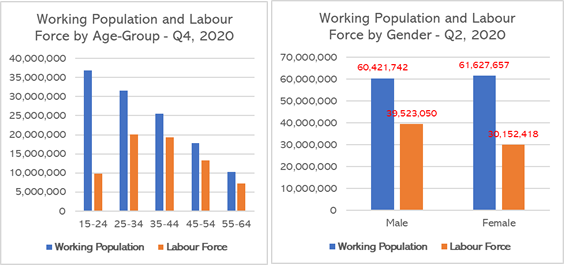
Unlike in the economicallyactive population, the age group that accounts for the highest number under thelabour force is the 25-34 age group. This is expected as most persons withinthe age group of 15-24 are involved in one form of schooling or the other,hence are not willing and/oravailable for work. While females are more dominant under the activepopulation, albeit marginal, the reverse holds for the labour force, wheremales are more dominant with 56.72%, with females accountingfor 43.28%.
| Labour Force - Q4, 2020 | |||
| Educational Qualification | Age-Group | ||
| None | 20,652,597 | 15-24 | 9,853,103 |
| 9,240,842 | 25-34 | 20,091,695 | |
| Middle School Leaving Certificate | 326,025 | 35-44 | 19,268,957 |
| Vocational/Commercial | 233,535 | 45-54 | 13,302,064 |
| Junior Secondary School Certificate | 3,351,293 | 55-64 | 7,159,648 |
| Senior Secondary School Certificate | 22,031,170 | Gender | |
| A' levels | 748,228 | Male | 39,523,050 |
| NCE/OND/Nursing | 5,779,243 | Female | 30,152,418 |
| BA/BSc/HND | 5,940,546 | Place of Residence | |
| Tech/Prof | 187,033 | Urban | 26,459,732 |
| Masters | 349,306 | Rural | 43,215,736 |
| Doctorate | 73,859 | Total | 69,675,468 |
| others (specify) | 761,792 | ||
Unemploymentand Underemployment Statistics - National Level
During the referenceperiod, the computed national unemployment rate rose from 27.1% in Q2, 2020 to33.3% in Q4, 2020, while the underemployment rate decreased from 28.6% to22.8%. A combination of both the unemployment and underemployment rate for thereference period gave a figure of 56.1%. This means that 33.3% of the labourforce in Nigeria or 23,187,389 persons either did nothing or worked for lessthan 20 hours a week, making them unemployed by our definition in Nigeria. Thisis an additional 1,422,772 persons from the number in that category in Q2,2020. Using the international definition of unemployment, the rate was computedto be 17.5%.

When considered by educationalstatus, those reporting A 'levels as their highest qualification had thehighest rate of unemployment with 50.7%, followed by those with firstdegree/HND at 40.1%. Those with Doctorate Degrees as their highestqualifications reported the lowest rate of unemployment, 16.9% during thereference period. Under the age-groupings, the highest rate of unemployment wasrecorded among the 15-24-year age-group with 53.4%, followed by those agedbetween 25-34 with 37.0%, together the youth population recorded anunemployment rate of 42.5%. In the case of underemployment by age grouping,those aged between 55-64 recorded an underemployment rate of 25.7%, the highestamongst the age groups. This was followed by those aged between 45-54 with24.4%, while those with the lowest underemployment rate were those aged between15-24 with 19.8%. A combination of unemployment and underemployment rates showsthat those aged between 15-24 reported a combined rate of 73.2%, showing aserious challenge for the age-group in secure full-time employment. Femaleunemployment was highest among the genders with 35.2% while male was 31.8%during the reference period. A similar case was recorded for underemployment,24.2% was reported for females, while males reported an under-employment rateof 21.8%. The unemployment rate among rural dwellers was 34.5%, while urbandwellers reported a rate of 31.3%. In the case of underemployment, ruraldwellers reported a rate of 26.9%, while the rate among urban dwellers was16.2%.
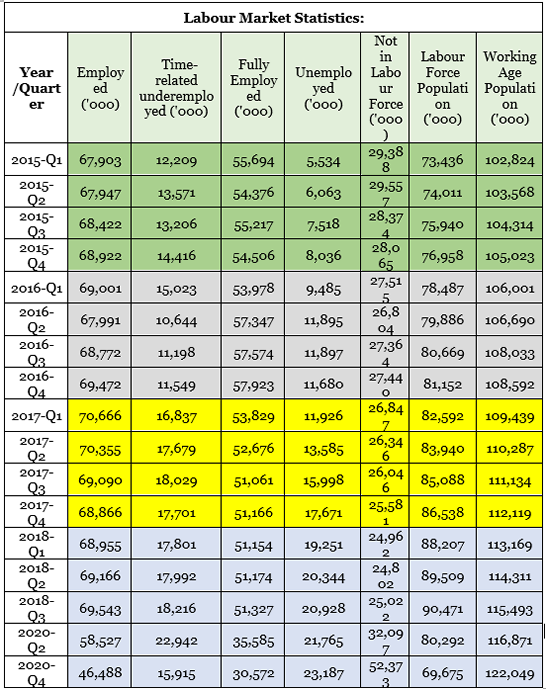
Unemploymentand Underemployment by State
In the case ofunemployment by state, Imo State recorded the highest rate of unemployment with56.64%. This was followed by Adamawa with 54.89% and Cross Rivers State with53.65%. The States with the lowest rates were Osun, Benue and Zamfara Stateswith 11.65%, 11.98% and 12.99% respectively. In the case of underemployment,Benue State recorded the highest rate with 43.52%, followed by Zamfara andJigawa States with 41.73% and 41.29% respectively.
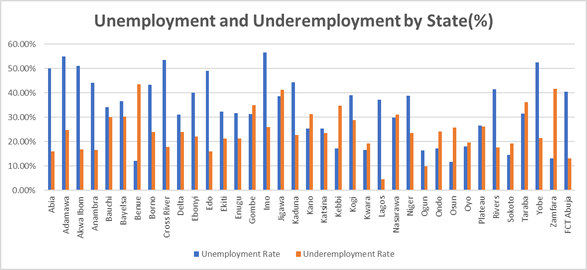
Combining both unemploymentand underemployment, the state that recorded the highest rate was Imo with82.5% followed by Jigawa with 80%. Ogun and Sokoto states recorded the lowestof the combined rates, 26.2% and 33.7% respectively.
InternationalUnemployment Rate
In comparison with othercountries across the world, we apply the International Labour Organisation'sstandard of 1-hour work per week. Using this measure, Nigeria's recentunemployment rate is 17.5%. Comparing this rate internationally, out of 181countries with rate published within the last 2 years, Nigeria currently ranksas the 19th country with the highest unemployment rate. Thecountries with the highest unemployment rates presently are Bosnia andHerzegovinian (33.7%), Namibia (33.4%), and South Africa (32.5%) while thosewith the lowest rates are Qatar (0.1%), Belarus (0.2%), Niger (0.3%) andMyanmar (0.7%). It is important to note that reference periods and methodologyof calculating unemployment rate could differ across the countries. Therefore,a direct comparison of unemployment rate in different countries may not bevalid.
Click Here to Download Q4 2020Labour Force Statistics PDF Report
Latest2021 NBS Reports

Q1 2021
1. Total Trade Higher By 8.9% in Q4 2020, Lower By10.3% in FY 2020
2. Average Price of 1kg of Tomato Decreased by-6.59% MoM in January 2021
3. Average Prices of PMS, AGO, HHK and Cooking Gas- January 2021
4. Nigeria Exits Recession, Real GDP Grew by 0.11%in Q4 and -1.92% in Full Year 2020
5. Headline Inflation Increases by 16.47% YoY InJanuary 2021, 0.71% Higher Than December 2020 Rate
6. FAAC Disburses N2.49trn to FG and N2.30trn to States in Year 2020 - NBS
7. FAAC Disburses N601.11bn in December 2020 - NBS
8. FAAC Disburses N604.00bn in November 2020 - NBS
9. Total Value of Capital Importation into NigeriaStood at US$1,069.68m in Q4 2020 - NBS
10. N295.72bn Generated as Company Income Tax in Q4 2020 - NBS
11. N454.69bn Generated as Value Added Tax in Q4 2020 - NBS
12. Average Price of 1kg ofTomato Increases by 17.51% YoY in December 2020 - NBS
13. Average Air Fare Increases by 18.54% YoY inDecember 2020 - NBS
14. Average Prices of PMS, AGO, HHK and CookingGas - December 2020
15. Headline Inflation Increasesby 15.75% YoY In December 2020, 0.86% Higher Than November 2020 Rate
16. 62.18% of Nigeria's TotalPublic Debt as of Q3 2020 Was Domestic - NBS
17. Active Voice Subscribers Grewby 4.59% in Q3 2020 - NBS
 Lagos, NG • GMT +1
Lagos, NG • GMT +1










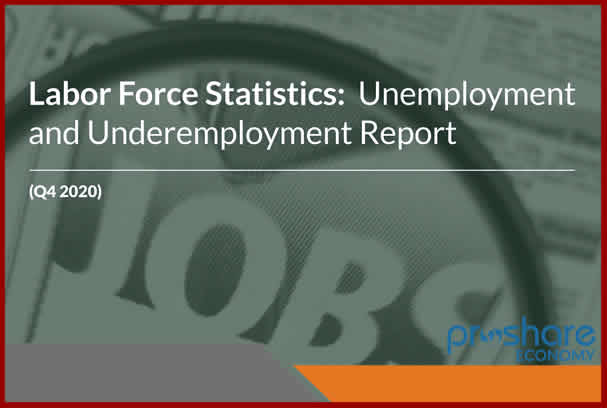
 7434 views
7434 views


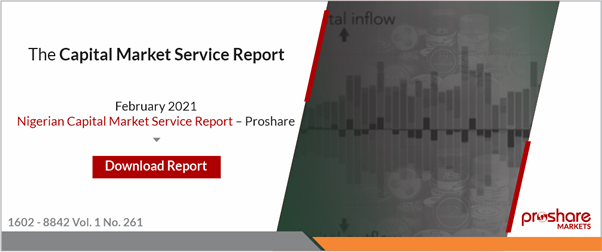

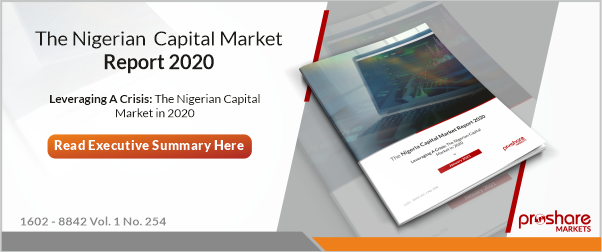






 Sponsored Ad
Sponsored Ad
 Advertise with Us
Advertise with Us









